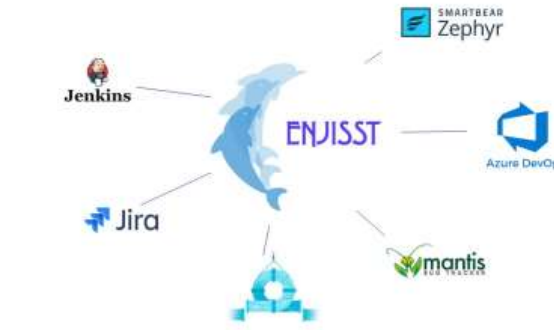

MANAGER
It contains dashboards of test executions, detected errors and their rates over time.
Main handler where:
- The design of the tests is carried out, from the idea, the sketch and the test script.
- Test execution is planned, both for simple tests and more robust plans and business cycles.
- Test results are analyzed and consulted
- Has major integration with external tools like CI/CD, error handlers and others

enabler
It is responsible for enabling the tests, preparing the scripts in user language to a technical level, in addition to preparing the parallelism of the tests, if applicable.
When executing the tests, the enabler analyzes the tests, their dependencies, reuses and data to be managed, enables the tests, so that the executions can be carried out in parallel, in addition to allowing the reported times to be of actual execution and not preparation.

Worker
t is responsible for the execution of the tests themselves. It is possible to have several DWorkers running in parallel, all managed through the Manager.
There are two types of Dworkers:
- Design and development dworker, which is aimed at testing people who are automating tests, and developers who are running their developments locally.
- Dworker-cloud product test, which is aimed at carrying test certification and doing large executions, in parallel.

CONCEPTUAL AND TECHNICAL COLLABORATIVE ARCHITECTURE
Achieving collaboration is more than being able to see the results of the executions that
other people do.
The features that Enjisst has to support collaboration are:
- Viewing detailed test reports executed by any person on the team, with detailed information on the test conditions, in each of the steps.
- Workers for both local use and cloud use, so that the same
test script can be run as unit tests and as part
of product certification.
- Download files used previously and during execution,
in order to have a subsequent analysis of the behavior of the test.
- Management of environments to modify the test conditions such as url
of use, data to be used, certain element identifiers, to support the execution of the same script in different test scopes
- Web test automation support and APIs, being able to combine the information between the interaction of the two, so that combined business cycles are created.
- Three types of test:
DESIGN TEST THAT REFERS TO THE TEST AUTOMATION PROCESS, THEREFORE ITS RESULTS SHOULD NOT AFFECT THE ANALYSIS REPORTS
DEVELOPER TEST THAT IS CARRIED OUT AT THE TIME OF DEVELOPMENT AND MAY OR MAY NOT BE INCLUDED IN THE ANALYZES OF RESULTS
KINDS OF TEST CASES
Test cases are oriented to be evolutionary over time, so that they are an option to apply the concepts of test-driven development, and they can also be written first manually and then automated:
Ideas: Name and description of the test, ideal for initial ideation or as feature acceptance criteria.
Sketches: Titles of the test steps, allow business experts to outline it before being detailed by an analyst.
Automated: Test steps grouped with DolphinScript statements for web, webservices, files, emails, etc. There are four types of sentences:
- Actions
- Validations
- Synchronization, to make special waits for the behavior of the system, and thus reduce the probability of false positives due to delays in the system to be tested
- Information extraction to make test cycles longer
- complete elements included in interaction between several applications, and/or
- webServices
Mixed: They combine automated tests with subsequent manual validations
CHARACTERISTICS OF THE SOFTWARE AND ITS RELATIONSHIP WITH TESTS
Three-level model to define the characteristics of the software to be tested. It has attributes to measure the impact of bugs on each feature.
Association of features to test cases for design coverage analysis and test execution.
BENEFITS OVER THE TESTING PROCESS
Tests are evolutionary throughout the life cycle.
INTEGRATION WITH TOOLS
Enjisst integrates with development lifecycle tools, which complement testing and DevOps management:
CI/CD CONTINUOUS INTEGRATION TOOLS
The execution of test plans and test cycles can be executed through services, from any CI/CD tool. Enjisst generates Jenkins pipelines, Bitbucket pipeline, Azure pipeline and generics.
ERROR MANAGEMENT TOOLS
Once a software bug is confirmed, integrated bugs are logged with tools like Jira, Azure, Mantis.
TEST MANAGEMENT TOOLS
If you want to use an additional test management tool, Enjisst integrates the creation of test cases and plans, in addition to the results of the execution of the cases included in Zephyr or TestPlan.

© 2021 Magis sas- All rights reserved.